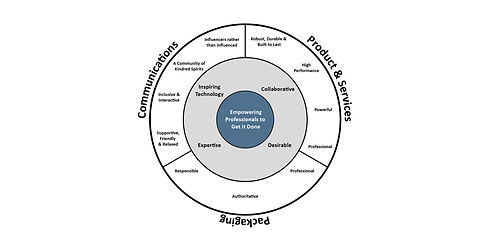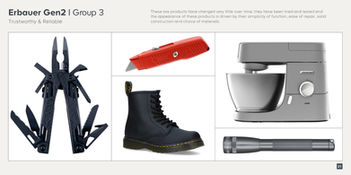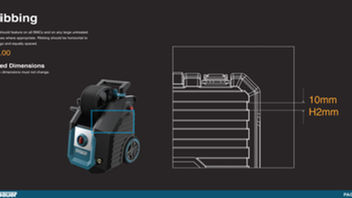
Creating
Consistency
A case study to illustrate the work and the processes used in creating a design language for a power tools brand.
Kingfisher has over 30 Own Exclusive Brands (OEB). Most of these brands have detailed Brand Books which outline how a brand should be communicated through print, photography, digital media and what the tone of voice should be, but nothing to describe how the brand is physically manifested in a product. The stages involved from the understanding the brand, translating values from words to imagery and creating a consistent design language are illustrated in this section for the evolution of the Erbauer tools brands.
Reasons to Evolve
Erbauer was created in 201x and was developed directly with a manufacturer. Kingfisher’s internal brand team also created collateral to communicate the brand and its tone of voice through print, graphics, photography, etc. At this time there was no defined industrial design language to communicate how products should look this was left to the vendor and feel. As component technology and performance evolved it became time to update the products, this was seen as an opportunity to update the designs and bring consistency of design across the range of products.
Starting from the Bottom Up
In order to evolve the brand, we needed to understand what the brand meant to its stakeholders and customers, I held two sessions with the brand’s stakeholders, internal brand team and our design team to do this. The first session involved understanding what words each person felt described the brand, The true meanings of the words were then translated into images to allow everyone to see what the words they had described looked like in physical 3d terms. In the second session, these image boards were used to help select the final words to make up the product side of the brand wheel.


Building the Design Language
The stakeholders did not want to lose any of the brand loyalty that had been built by the existing products and for them it was important to ensure the new designs were an evolution rather than a complete redesign. The new products were designed using the new values in conjunction with elements of existing products. During the design process certain design 'cues,' were created that would be used across all of the products to bring consistency to the range, these cues were documented in the design language guide, some of the pages are shown below.

Executing the Design Language
The early work to define the underlying look and feel of the brand is concretised in a design language guide which details the various design cues and signifiers that make the brand recognisable. This process happens during the design phase of some of the products and enables future products to be designed using the design language guide. Below are images of the Erbauer Pressure washers which were some of the first products to embody the Erbauer Generation 2 design language.


































